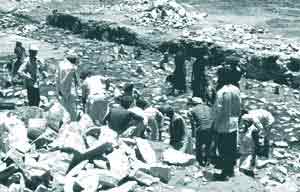| |
NETWORKING |
|
| Yatra with a difference Who were the pilgrims The yatris said... |
||
INITIATIVE |
||
| Orissa's efforts People rediscover water |
||
POLICY |
||
| Communities do have an answer |
||
DROUGHT |
||

| Vol. 3 | No. 1 |
Februray 2001 |
People rediscover water
Shri Kundla Taluka Gram Seva Mandal (SKTGSM) is a social welfare organisation in Savarkundla district, Gujarat whose main emphasis is on achieving goals through community participation. The organisation has been a driving force behind all social welfare activities in the area since pre-independence.
The Water Resource Development Project that commenced in October 1995 was conducted with the help of Sarvodaya Yojana and bodies of local farmers to solve the water scarcity problem of 35 villages in Savarkundla district. Within two years of the project, results in the form of sustenance through the drought period and rise in the agricultural yield were visible.
As in other areas in Saurashtra region, the scarcity of water for drinking and agriculture is a severe problem for people in Savarkunda taluka. The geographical features of the area make it difficult for the region to benefit from the Narmada project or any such irrigation projects. The groundwater resources have been depleting with declining aquifer levels. Thus SKTGSM initiated the Water Resource Development Project to fight the water problem by conserving rainwater and recharging the aquifers.
 |
People in Savarkundla working hard to mitigate their water crisis |
The water resource development project was designed on the lines of the decentralised working system and required active participation from the beneficiaries (in this case the villagers). The beneficiaries had to select the location and plan for water conservation. They had to appoint the technicians for the construction, supervise and watch over the expenditure and materials. The three year long project had an estimated expenditure of Rs 296 lakh, out of which 20 per cent expenditure had to be borne by the beneficiaries and the rest by the government. Initially the villagers were hesitant about taking the initiative in the project. They were used to government driven water projects, which more often than not, had failed to deliver the desired results.
SKTGSM formed 34 village level committees to spread awareness about the aims and benefits of the project and the importance of their involvement for its success. As a result a number of people came forward and offered their land for construction of various rain harvesting structures such as Percolation tanks, check dams and nallah plugs. And as the project caught pace more work was completed in the scheduled time duration and the water table rose from 5 feet to 15 feet in 2,480 wells. Not only this, the villages also experienced an unprecedented profit in their agricultural product amounting to 62 per cent and 187.5 per cent in the first and the second years respectively. The beneficiaries are responsible for the sustenance of the assets created at the village level. Approximately five percent of the total estimate is deposited in the bank well in advance for the villagers to utilise in the maintenance of the assets. According to Sonabai, a shephard from Pitavadi, "Due to water being available in our village, we are not dependendent on external sources for our livelihood security All of us are now keen to grow millet, cotton, vegetables and mango in our agricultural fields." Sharing the same viewpoint is Gaurbhai Mamad of Madhda," We were groping in the dark till the execution of the project. The project has solved all our problems. Earlier, we were staying in dilapidated houses but now we haveconstructed new mud houses for ourselves. Water has brought self-reliance in the village."
Work accomplished under the water resource development project |
||
| Description of work | Goal | Achievement |
| Kachcha bandhara (raw water encloser) | 800 | 826 |
| Pucca check dam (built check dam) | 80 | 78 |
| Pond | 12 | 30 |
| Soil leveling | 3,500 hectares | 3,711 hectares |
| Tree plantation | 3 lakh distributed | 1,21,800 planted |
The project has been successful in minimising the water crisis, but a number of challenges lay ahead of the villagers. The villagers have been given the responsibility of maintaining the assets created under the water resource development project. But they require further orientation towards traditional water harvesting systems lest the problems reappear due to mismanagement and exploitation. In order to incorporate gender equity in sharing of the natural resource, an effort is required to mobilise women towards forrmation of women’s organisations. The irrigation methods need to be improved. People need to respect and guard their self-reliance to reap the fruits of success.